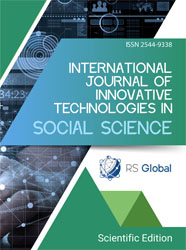SOME ASPECTS OF THE INTEGRATION OF PEER-ASSESSMENT IN EFL WRITING CLASSROOM (CASE OF GEORGIA)
Abstract
Writing skills are considered to be the most challenging skills for a second language learner to master. Large number of studies have been carried out to address this issue. The researchers emphasise the vital role of adequate pedagogical approach, fair assessment, and constructive feedback in teaching writing. The main focus of this study is peer assessment, as one of the most effective techniques for developing writing skills by giving feedbacks and assessments. However, this technique, similar to any other methodological tools, can encounter the problems. This research highlights some of the major problems encountered in the peer assessment process and suggests recommendations for their solution. Empirical data of this study are collected from self-reflective classroom practice of peer-assessment. Quantitative analysis is performed on the points assigned by the peers and by the professor by using t-test. Qualitative analysis is carried out based on class observation and thematic analysis of the feedbacks provided by the participants. The results of the research show that the most significant factors that hinder successful implementation of peer assessment in EFL classroom in Georgia, are the social factor of friendship and the lack of oral interaction between the reviewer groups and the reviewees. Respectively, adoption of the two-fold model of peer-assessment that includes: 1. Written format of peer-assessment with final points assigned by the professor and 2. Oral interaction between the assessor(s) and assessed students, makes the peerassessment one of the most effective techniques for developing writing skills in EFL classes in Georgia.
References
American Psychological Association. (2013). APA guidelines for the undergraduate psychology major: Version 2.0. Retrieved from http://www.apa.org/ed/precollege/about/psymajor-guidelines.pdf
Dar, M. F., Zakie, S., & Kazmi, H. H. (2014), ‘’Peer Assessment in EAP Writing: An Effective Strategy for Large Classes, ’’Journal of Educational Research, 17(1), 50. https://www.researchgate.net/publication/310333708_Dar_M_F_Zaki_S_Kazmi_H_H_2014_Peer_Assessment_in_EAP_Writing_An_Effective_Strategy_for_Large_Classes_Journal_of_Educational_Research_171_50
Dochy, F., Segers, M., & Sluijsmans, D. (1999). The use of self-, peer and co-assessment in higher education: A review. Studies in Higher Education, 24(3), 331–350. https://doi.org/10.1080/03075079912331379935
Double, Kit S. & Joshua A. McGrane1 & Therese N. Hopfenbeck (2019), ‘The Impact of Peer Assessment on Academic Performance: A Meta-analysis of Control Group Studies’, Educational Psychology Review https://doi.org/10.1007/s10648-019-09510-3
Finch, A. (2014) Participant Perceptions of Peer Editing in an EFL Freshman English Program, https://www.researchgate.net/publication/263735019_Participant_Perceptions_of_Peer_Editing_in_an_EFL_Freshman_English_Program_Participant_Perceptions_of_Peer_Editing_in_an_EFL_Freshman
Hanushek, E.A, Kain, J.F, Markman, J.M, &Rivkin. (2003). Does peer ability affect student achievement? Journal of Applied Econometrics. (18), 527-544. Doi: 10.1002/jae.741. https://doi.org/10.1002/jae.741
Liu, J& Hansen, J. (2002). Peer Response in Second Language Writing Classrooms. Michigan: University of Michigan Press. https://www.researchgate.net/publication/306059410_Peer_Response_in_Second_Language_Writing_Classrooms
Lyons, B. (1981). The PQP method of responding to writing. English Journal, 70(3), 42043. Monologue, T.
https://eric.ed.gov/?id=EJ242167
Ober, Teresa Flores Roseanne Lucille (2020) City University of New York - Hunter College University of Notre Dame, Enhancing Academic Writing Skills Using a Peer Review Process, Research Gate, https://www.researchgate.net/publication/341895252
Panadero, E., & Alqassab, M. (2019). An empirical review of anonymity effects in peer assessment, peer feedback, peer review, peer evaluation and peer grading. Assessment & Evaluation in Higher Education, 1–26. https://doi.org/10.1080/02602938.2019.1600186
Reinholz, D. L. (2015). Peer-assisted reflection: A design-based intervention for improving success in calculus. International Journal of Research in Undergraduate Mathematics Education, 1(2), 234 267, https://link.springer.com/article/10.1007/s40753-015-0005-y
Rotsaert, T., Panadero, E., & Schellens, T. (2018). Anonymity as an instructional scaffold in peer assessment: its effects on peer feedback quality and evolution in students’ perceptions about peer assessment skills. European Journal of Psychology of Education, 33(1), 75–99. https://www.researchgate.net/publication/318911091_Anonymity_as_an_instructional_scaffold_in_peer_assessment_its_effects_on_peer_feedback_quality_and_evolution_in_students'_perceptions_about_peer_assessment_skills
Shamim, F. (2008). Trends, issues, and challenges in English language education in Pakistan. Asia Pacific Journal of Education, 28(3). 235 – 249. https://www.tandfonline.com/doi/abs/10.1080/02188790802267324
Spear, K. (1987). Sharing Writing: Peer Response Groups in English Classes. Portsmouth, NH: Boynton/Cook Publishers, Inc.
Strijbos, J. W., & Wichmann, A. (2018). Promoting learning by leveraging the collaborative nature of formative peer assessment with instructional scaffolds. European Journal of Psychology of Education, 33(1), 1–9. https://www.jstor.org/stable/44951937
Vanderhoven, E., Raes, A., Montrieux, H., Rotsaert, T., & Schellens, T. (2015). What if pupils can assess their peers anonymously? A quasi-experimental study. Computers & Education, 81, 123–132. https://www.researchgate.net/publication/266678031_What_if_pupils_can_assess_their_peers_anonymously_A_quasi-experimental_study
Views:
298
Downloads:
256
Copyright (c) 2022 Inga Diakonidze

This work is licensed under a Creative Commons Attribution 4.0 International License.
All articles are published in open-access and licensed under a Creative Commons Attribution 4.0 International License (CC BY 4.0). Hence, authors retain copyright to the content of the articles.
CC BY 4.0 License allows content to be copied, adapted, displayed, distributed, re-published or otherwise re-used for any purpose including for adaptation and commercial use provided the content is attributed.











